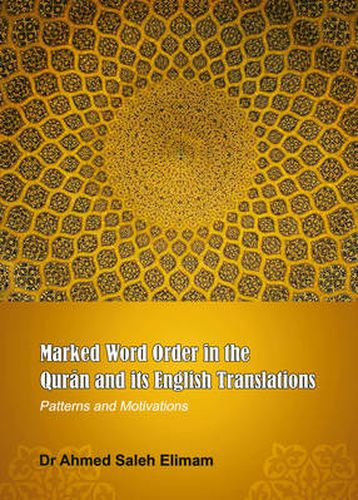Readings Newsletter
Become a Readings Member to make your shopping experience even easier.
Sign in or sign up for free!
You’re not far away from qualifying for FREE standard shipping within Australia
You’ve qualified for FREE standard shipping within Australia
The cart is loading…






The literature on Balaghah (the art of Arabic eloquence) and commentaries on the Quran stress that the style of the Quran is beautiful, eloquent and inimitable. This literature identifies word order as one of the most distinctive aspects of Quranic style. One of the main reasons for this is that, compared to English, Arabic has fewer restrictions on word order, thanks to its elaborate verb inflection system and case marking. This flexibility allows for the foregrounding of some elements within the sentence, resulting in a marked (or non-canonical) word order and fulfilling certain discursive functions, including specification, restriction, emphasis, amplification/ glorification, and denial. Marked word order is used to highlight or downplay certain elements in speech or writing. It constitutes one way of delivering meanings to the addressee, as these meanings are ordered in the mind of the speaker in terms of their importance, making the style a precise reflection of the speaker’s mind and feelings.This book is a descriptive study which attempts to examine how translations of the Quran have handled ayahs (verses of the Quran) that feature lexical foregrounding, focusing on ten published translations into English, carried out by translators from different ideological and linguistic backgrounds. It offers a systematic comparison of the ways in which the selected translators deal with the linguistic feature of word order variation, and examines issues relating to the translator’s style. Specifically, the book identifies and examines the following: instances of marked word order discussed by commentators on the Quran, and the function served by each case of lexical foregrounding; secondly, the options and/or patterns employed by translators to render the different functions of marked word order; thirdly, the recurrent options and/or patterns for rendering different types of word order variation. Finally, the book explores the factors which may have influenced the choice of particular strategies by different translators, including the translators’ motivations and the various historical contexts in which the translations were made.
$9.00 standard shipping within Australia
FREE standard shipping within Australia for orders over $100.00
Express & International shipping calculated at checkout
The literature on Balaghah (the art of Arabic eloquence) and commentaries on the Quran stress that the style of the Quran is beautiful, eloquent and inimitable. This literature identifies word order as one of the most distinctive aspects of Quranic style. One of the main reasons for this is that, compared to English, Arabic has fewer restrictions on word order, thanks to its elaborate verb inflection system and case marking. This flexibility allows for the foregrounding of some elements within the sentence, resulting in a marked (or non-canonical) word order and fulfilling certain discursive functions, including specification, restriction, emphasis, amplification/ glorification, and denial. Marked word order is used to highlight or downplay certain elements in speech or writing. It constitutes one way of delivering meanings to the addressee, as these meanings are ordered in the mind of the speaker in terms of their importance, making the style a precise reflection of the speaker’s mind and feelings.This book is a descriptive study which attempts to examine how translations of the Quran have handled ayahs (verses of the Quran) that feature lexical foregrounding, focusing on ten published translations into English, carried out by translators from different ideological and linguistic backgrounds. It offers a systematic comparison of the ways in which the selected translators deal with the linguistic feature of word order variation, and examines issues relating to the translator’s style. Specifically, the book identifies and examines the following: instances of marked word order discussed by commentators on the Quran, and the function served by each case of lexical foregrounding; secondly, the options and/or patterns employed by translators to render the different functions of marked word order; thirdly, the recurrent options and/or patterns for rendering different types of word order variation. Finally, the book explores the factors which may have influenced the choice of particular strategies by different translators, including the translators’ motivations and the various historical contexts in which the translations were made.